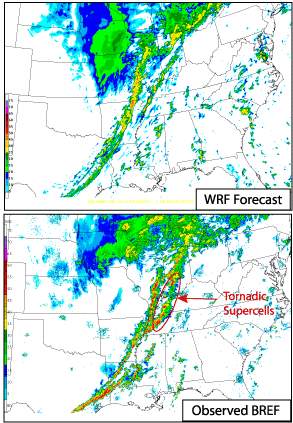EFP: 2005 Spring Experiment Summary
Working Hypotheses
- Numerical modelers can learn to incorporate more operational relevance in their research efforts if they work closely with forecasters in an experimental forecasting exercise.
- Operational forecasters can make more skillful interpretations of numerical model output if they work with numerical modelers in an experimental forecasting exercise.
Specific Objectives
Research Perspective
- To identify characteristic behaviors and specific strengths/weaknesses of the different WRF configurations and provide focused feedback to model developers on the performance of the experimental WRF models during severe thunderstorm episodes.
- To evaluate the sensitivity of explicit convective forecasts to grid resolution by comparing forecast with 2 km and 4 km grid spacing.
Operational Perspective
- To identify characteristic behaviors and specific strengths/weaknesses of the different WRF configurations and provide focused feedback to model developers on the performance of the experimental WRF models during severe thunderstorm episodes.
- To evaluate the sensitivity of explicit convective forecasts to grid resolution by comparing forecast with 2 km and 4 km grid spacing.
Preliminary Results
- Numerous systematic biases were identified in different configurations of the WRF and linked to various physical parameterizations. Biases were reported to model developers.
- The different WRF configurations performed with comparable skill in predicting mesoscale aspects of convective initiation and evolution; there was no clear advantage for 2 km grid spacing.
- Newly developed algorithms appeared to be quite effective at identifying rotating updrafts in model output.
- Simulated reflectivity fields derived from model output revealed detailed mesoscale structures that were not evident in traditional output fields.
Payoff
- Numerical modelers at NCAR and NCEP/EMC are mitigating systematic biases revealed during the program, especially those associated with turbulence/boundary layer parameterizations.
- SPC forecasters are becoming skillful users of convection-allowing models. Experimental high-resolution model runs continue on a daily basis at EMC and output from these runs has had a positive impact during several severe weather outbreaks.
Related Publications
- Kain, J. S., S. J. Weiss, M. E. Baldwin, G. W. Carbin, D. R. Bright, J. J. Levit, and J. A. Hart, 2005: Evaluating high-resolution configurations of the WRF model that are used to forecast severe convective weather: The 2005 SPC/NSSL Spring Program. Preprints, 21th Conference on Weather Analysis and Forecasting/17th Conference on Numerical Weather Prediction, Washington, D. C., Amer. Meteor. Soc., CD-ROM, 2A.5.
- Kain, J. S., S. J. Weiss, D. R. Bright, M. E. Baldwin, J. J. Levit, G. W. Carbin, C. S. Schwartz, M. L. Weisman, K. K. Droegemeier, D. B. Weber, K. W. Thomas, 2008: Some practical considerations regarding horizontal resolution in the first generation of operational convection-allowing NWP. Wea. Forecasting, 23, 931–952.
- Koch, S. E., B. Ferrier, M. Stolinga, E. Szoke , S. J. Weiss, and J. S. Kain, 2005: The use of simulated radar reflectivity fields in the diagnosis of mesoscale phenomena from high-resolution WRF model forecasts. Preprints, 11th Conference on Mesoscale Processes, Albuquerque, NM, Amer. Meteor. Soc., CD-ROM, J4J.7


